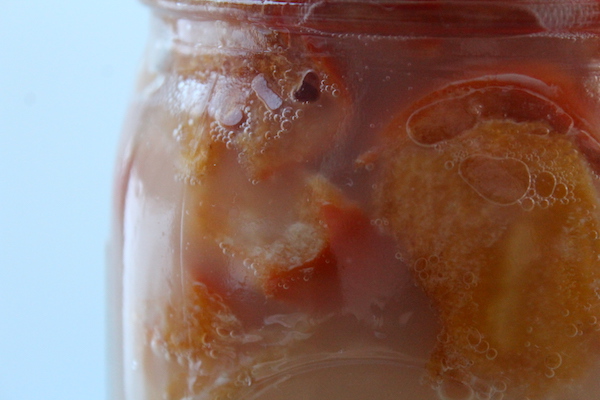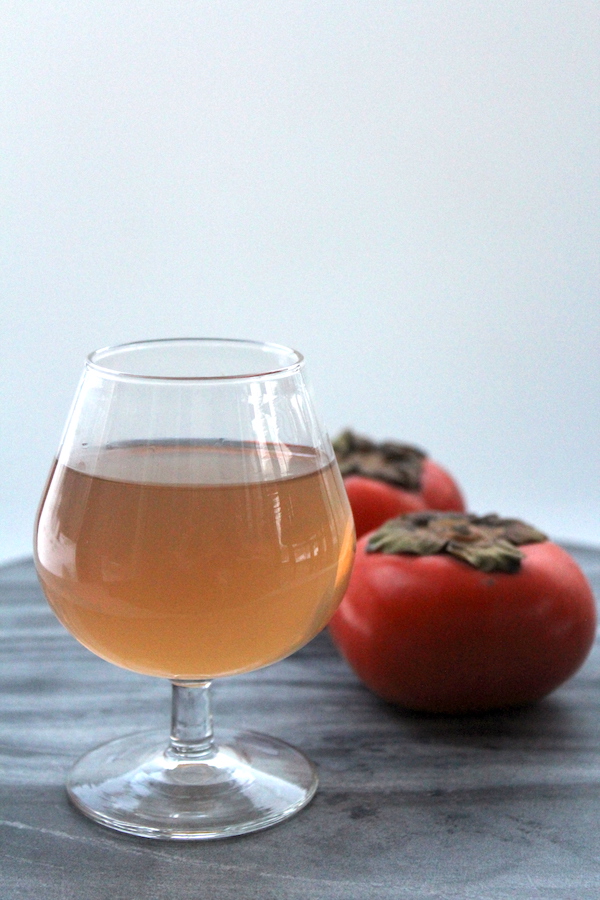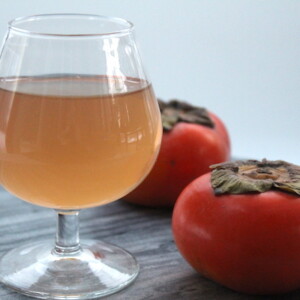Affiliate disclosure: This post may contain affiliate links. Please see our Privacy Policy.
Persimmons are one of the very last fruits of the year, ripening in November and December. This late season allows you to get one more batch started before the new year, and homemade persimmon wine is a good way to finish out the year.

Persimmons can be expensive, but I found a great deal this year. The vast majority of them went into homemade persimmon jam, which is one of my family’s favorites.
After that, my kids devoured an out-of-this-world persimmon upside-down cake made with honey and almond flour. Still, there were more persimmons!
What else to do when you’ve exhausted your creativity? Ferment it! Persimmon wine is the obvious solution.
Since persimmons can be a bit on the pricey side, I’ve made this as a small batch wine recipe, using a quart jar and a mason tops waterless silicone fermentation cap.

In the past, we’ve tried to extract juice from persimmons using a small home juicer. They’re really starchy fruits though, even when dead ripe. That extra starch allows them to thicken up into a jam without pectin, but it also stops them from gushing with juice without a bit of work.
This time I tried the same sugar juicing method that I used with my rhubarb wine and peach wine. Simply slice up the persimmons and add the sugar directly over the top of them in a mason jar. I know, it looks preposterous, but in just a few hours the cells will pop and the persimmon slices will be deflated down to almost nothing and floating in a nearly full jar of their own sugary juice.

After the persimmons give up their juice, you can either muddle them down to extract the last bits and then remove them, or leave them in and add the remaining ingredients on top. If I had it to do over, I’d remove them because they take up quite a bit of space in the jar which will lower the yield a bit unless you backfill with water after the primary.
They also can clog up a water-lock if the ferment gets going too hard, but that’s why I like these waterless silicone lids. I’ve yet to have one clog even with chunky fruit in there.
Either way, I’d recommend filtering out the fruit after 8 to 12 hours in the sugar and then using a bit of water to wash off the last bits of residual sugar from the fruit into the jar. That way you get as much persimmon flavor into the wine as possible.

This is a pretty simple wine recipe, and it doesn’t call for much. I didn’t use pectic enzyme to clarify the wine, and it shows in the somewhat cloudy finished product. I would recommend adding pectic enzyme, and I’ve included that in the recipe.
I’ve added quite a bit of acid to this recipe in the form of lemon juice. Persimmons need a bit of acid to bring out their flavor in my opinion, but for a more neutral flavor try using winemaking acid blend instead of lemon juice.

For reference, here’s a quick rundown on the basic winemaking additives that you could use in any wine recipe:
- Pectic Enzyme for breaking open the mango fruit cells.
- An acid blend to decrease the overall pH.
- Yeast Nutrient to feed the little beasties and give them the micronutrients that help them thrive.
- Tannin to give the sweet wine a bit of astringency and balance the flavor.
- Potassium Sorbate and Camden tablets (potassium metabisulfite) to completely end the fermentation and stabilize the wine before bottling.
For this recipe, I’ve omitted the tannin, as even the big 5-gallon batch recipes I can find only use 1/2 tsp across 5 gallons. I’ve also omitted the stabilizers (potassium sorbate) because I accidentally ingest enough of that garbage in anytime I eat packaged food, and I’m not about to go adding it to my homemade goods on purpose. If you’re familiar with wine stabilizers to stop fermentation and you’re comfortable with using them then that’s your choice.

A couple other things to note. This recipe is for a small batch one quart of persimmon wine.
If you want to make a full one-gallon batch, no problem, just multiply by 4. Similarly, a big 5-gallon batch can be made by multiplying all the ingredients by 20.
If you are going to make a one-gallon batch leaving the pulp in, I’d highly recommend investing in a wide-mouth one-gallon jar equipped with a waterlock. Cleaning fruit pulp out of narrow neck carboys is an unholy pain, and these jars are a great inexpensive solution for a much cleaner primary ferment.

Homemade Persimmon Wine
Ingredients
- 3/4 lb persimmons, about 2 large fuyu
- 10 oz sugar
- 1 tbsp lemon juice, or 1tsp acid blend
- 1/4 tsp Pectic Enzyme
- 1/4 tsp yeast nutrient
- 1/4 wine yeast, dissolved in water
Instructions
- Slice persimmons and place them in a quart mason jar. Top them with sugar and allow the sugar to extract the persimmon juice for 8 to 12 hours.
- Filter out the persimmon pulp, muddling it a bit to extract the last bits of juice. Pour a small amount of water over the pulp to extract a bit more flavor and put that into the jar. (or, if you prefer, leave the pulp in the primary and filter it out after the initial ferment after 7 days)
- Add in the acid source (lemon juice or acid blend), yeast nutrient and pectic enzyme.
- Dissolve the wine yeast into a bit of water and allow it to rehydrate for at least 5 minutes. Then add it into the fermenter.
- Add more water as required to fill the jar to within 1 inch of the top. Put on a mason jar airlock and allow the mixture to ferment for 5 to 7 days, until fermentation visibly slows.
- Carefully pour the wine off into a new jar, leaving any sediment or pulp behind. If you left the persimmon pulp in, this is the time to filter it out.
- Refill the secondary fermenter jar to within 1 inch of the top and allow the wine to ferment for an additional 4-6 weeks until the wine begins to really clear and fermentation slows to a stop.
- Bottle the wine in flip top grolsch bottles and allow it to age for about at least a month before drinking (ideally 3-4 months). For larger batches, one gallon or more, bottle in wine bottles with corks for better results.
Notes
Nutrition
Nutrition information is automatically calculated, so should only be used as an approximation.
More Wine Recipes





I planted about six persimmon trees back in ’21, and I’m hoping that they will fruit this upcoming year. They are American persimmons, and I was wondering if that would make a difference. Also, I was wondering if a steam juicer might make the process a little cleaner, as far as “debris” in the ferment. Thanks for any guidance! Yesterday I bottled my blueberry wine and racked the peach wine using your recipes! You’ve never steered me wrong and it’s nice to know that you actually use the recipes you put out!
So far, I’ve also made dandelion, rhubarb and strawberry wines and am always newly surprised that they come out so well and actually taste good; making wine seems like such an advanced thing to make, yet it’s one of the more simple things one can do. Most of the time, it just sits there; other than that, if you can boil water and measure stuff, it’s easy-breezy. The hardest part is wrangling the syphon tube!
When my hawthorn tree gets bigger, I’ll be eager to try that recipe. Funny, I have a few grape vines, yet have never made wine using grapes–it just seems to obvious!
So glad to hear it Barbara! Grape wine is actually the trickiest one in my opinion, and I’ve never made one that I really loved. We have made many gallons…and it all goes into marinades or vinegar, because I’m never happy with it. I think there’s some kind of magic that old school wineries have that makes their wine so darn good…but the fruit wines are easy!
I just wanted to thank you for this recipe AND the concept of using quart Mason jars with silicone fermentation caps to make the wine. We tried three quart jars with the caps and followed your instructions – and wound up with three 750 ml bottles of persimmon wine that look very much the same shade as that in the glass you have pictured. It’s not bad at all. Hopefully it will be another use for our Fuyu persimmons.
Wonderful! So glad it worked out for you =)
In step 7 it says to refill the jar leaving 1 inch. Is that refill with water? Thank you so much.
The headspace on the wine doesn’t have to be exact as long as it’s not too much of a headspace. You can add a little water if you need to but you don’t want to add a lot since this will water down your wine.
How ripe should the persimmons be? We often eat them when they are still hard like apples but I imagine for wine they should have a little more give to them? Perhaps like a ripe peach?
Thank you for your recipe. I can’t wait to try it!
You definitely want them to be ripe to get the best flavor.
Do I have to add the yeast nutrient ?
It’s not necessary but helpful especially when using fruits other than grapes which may not have all the right micronutrients. You can also use a few raisins instead.
In the second fermentation, do you use regular caps on the Madon jars, or continue with the Mason Tops?
You need to continue with mason tops (or some other water lock like top) that will allow CO2 to escape. If it’s actively fermenting at all, it will explode if that cannot escape.
Can you use frozen persimmon flesh?
Yup!
What type of wine yeast do you use?
I usually use red star champagne yeast (which is now called Premier Blanc), because it’s a dependable fermenter that doesn’t add much in the way of flavor. There are probably better choices that would add flavor that compliments the wine, and finish at a lower alcohol concentration, but that’s what I use in most my batches unless I’m really trying for something specific.
Is a mason top waterless silicone fermentation cap absolutely required? I’ve never fermented anything before, but I’ve heard using a regular mason jar lid and burping it will work as well. If so, how will that work in this recipe, if at all? Additionally, in step 7, you say to ferment for an additional 4-6 weeks. Would we be using a regular lid or the fermentation cap for this period of time? Sorry, I’m an absolute beginner at this, but this recipe looks like fun!
So the reason you use a water lock specifically with wine is that it prevents acetic acid (vinegar causing) bacteria from forming. You can burp the top, but instead, I’d suggest actually just caping it very loosely. In the primary ferment, it’ll be off-gassing a lot, and you’d have to burp it constantly. I actually talk about options besides water locks in this article I have on making mead, and people use all manner of things (like a balloon with a pin hole poked in it).
Came into a bounty of Hachiya persimmons, so surfing for ideas to use them. Your posts are the ticket. Thank you! I’ve never made wine before. Question, these Hachiya will be quite mushy in just a few days. I’ll be able to scoop the pulp out of the skin. Can I use honey instead of sugar?
Yup, you can use honey instead of sugar, no problem. Enjoy!
When do you add the potassium sirbate? And how much do you use. I read and reread your recipe, but I couldn’t find where you actually used it. Thanks!
It’s not listed in the recipe because we don’t use it in our wine. One of the reasons why we make it ourselves is to avoid those kinds of ingredients. If you decide to use it, the instructions should be on the product. It is added before bottling.
Try honey instead of white sugar. Sugar washes don’t taste as well but when you make it, boil the persimmons and I would do a half cup raw organic honey then strain it and let it cool, add your nutrients and acids and then ferment it. The honey will add natural depth without adding tannins
Sorry, boil in 1 gallon water
Hi John,
I really like your tip. When you strain the boiled mixture to ferment, do you leave the persimmon pulp during fermentation? Or just add the liquid and nutrients and then store it for 4-6 weeks? In other words, Does your process remove some of the steps listed above?
Did I do something wrong if my jar isn’t filled with juice after 12 hrs? Never done any of this before so I’m on a complete learning experience. I’m in southeast Missouri using wild persimmons. I’ve harvested the ones off the ground to make sure they’re ripe enough. I just put the whole thing in minus the tops. Also squished them a bit before putting in the jar just for good measure. Put the sugar on top and put the lid on and put them away to do its thing. But there’s no juice like what you had described yours looking like. Just wondering if I did something wrong or just need to let it sit longer. Thanks
Maybe try muddling it a bit to extract some more juice and then filter out the pulp and see what you have.
Would this sugar method work for other fruits as well? I was thinking of using pears but don’t have a way to juice them.
It works with rhubarb and peaches too so I would definitely try it with pears. Let us know if it works out for you.
I suspect the seeds if cut or crushed would be problematic. But, leaving them in through the first ferment seems to be reasonable. If anything, they probably add some tannin which fruits sorely lack relative to grapes.
Great article I am collecting persimmons now for a batch.
Did you put seeds and all in the jar? I’m trying to make some persimmon wine with some small type persimmons that grow wild on my homestead in Tennessee. I was originally deseeding the persimmons but there is not much persimmon left after doing so. Just wondering which I should do. This is my first attempt at making any kind of wine. Help! Thanks!
Mine only had a few big seeds, so I just sliced them and the seeds popped out. That said, there’s no real reason to remove the seeds when making persimmon wine (as far as I know). Save yourself some time and just leave them, it’ll all get filtered out soon enough anyway.
I live in TN also and LOVE the natural persimmons! My husbands aunt taught me to gather up the persimmons wash them gently and pull out the little stems. Place about 6 to 10 persimmons in a (I use a metal colander) colander set the colander in a big bowl and start smashing skins seeds and all. The pulp will go into the bowl. 1 large colander filled with whole persimmons will produce about 8 cups of pulp. As you smash about every 4 times wipe the pulp from the bottom of the colander and rise it off so not to push any skin into the pulp.
Believe me I was peeling persimmons for about 4 hours. You will be amazed how much pulp you get in such little effort.
Thanks for the great tip Cory!